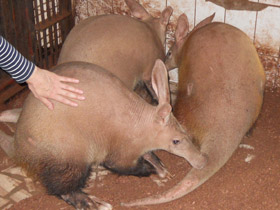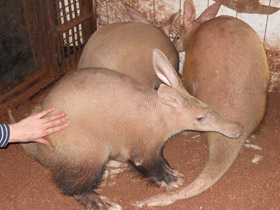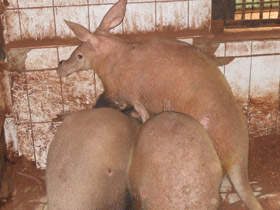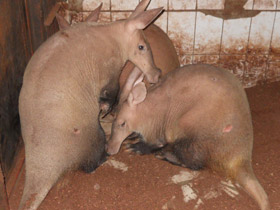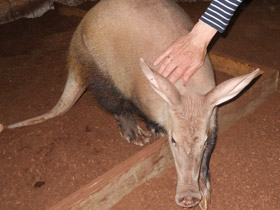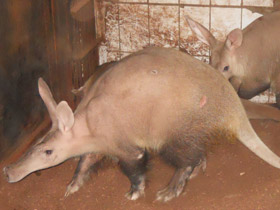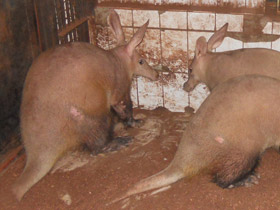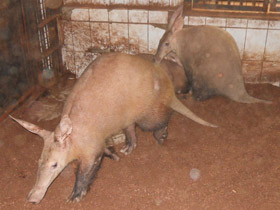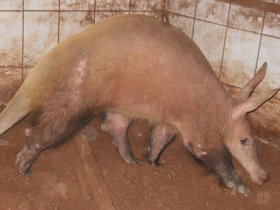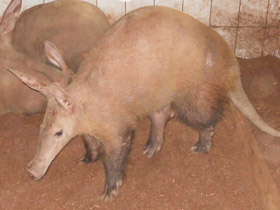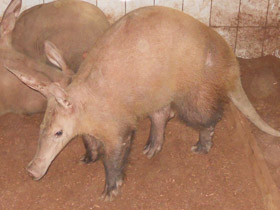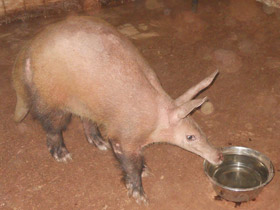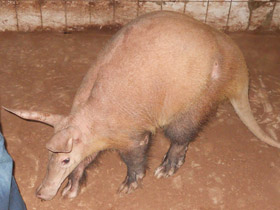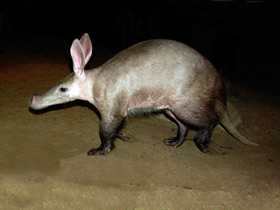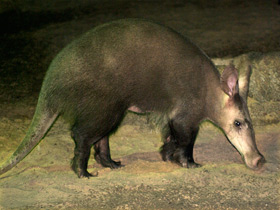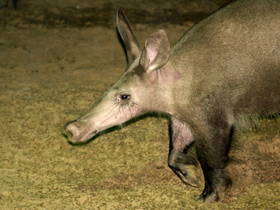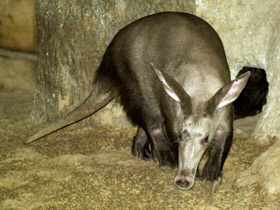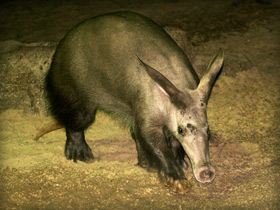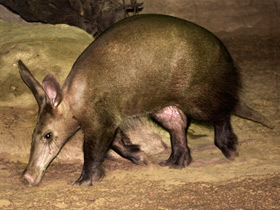The aardvark, or antbear Orycteropus afer
The aardvark, or antbear is the only living representative of an entire order of animals, the Tubulidentata. This animal is unique and very rare. The aardvark looks like it is a made up animal: its stocky body is similar to the body of a pig (this feature could be responsible for its name, which comes from the Afrikaans meaning “earth pig”).
But this “pig” has long, pointed ears of a donkey, which may be as long as 22 cm. Its thick, muscular tail is dragged on the ground; the elongated snout has tubular shape, and the feet are equipped with large, strong claws suited to burrowing and somewhat resembling hooves. The aardvark was first described in 1719 by Dutch traveller Peter Kolb but the description was so unusual that the Europeans could not believe that such a animal existed until the first aardvarks were brought in to Europe. People who see the aardvark for the first time often think it is an anteater though these two animals are not related. Aardvarks and anteaters look similar and eat the same food, termites and ants, but otherwise they do not have much in common.
The aardvark is relatively large animal; its body length reaches 1.5 m, with the tail measuring over 60 cm. Its shoulder height is about 60 cm. An aardvark's weight may reach 82 kg but is typically between 50 and 70 kilograms. One of the most distinctive characteristics of the aardvark is its unique peg-like teeth which have no enamel coating or roots and are worn away, regrowing continuously. Thick pinkish skin of the aardvark is covered with sparse coarse hairs which have brownish-grey or yellowish-grey colour. A new study suggests that the ancestor of all placental mammals was a tiny, furry-tailed creature that looked very much like an aardvark.
The Aardvark is widely distributed south of the Sahara. Within its large range, the aardvark occurs in a great variety of habitats, avoiding only dense forests. The aardvark is generally solitary. This elusive animal spends daytime underground and emerges from its burrow to feed in the dark. It walks slowly and awkwardly, and often stops on its tracks and stands still, supported by its powerful tail. The aardvark has a primitive brain and poor eyesight but it has acute hearing and a good sense of smell. A slightest rustling makes the animal hide in its burrow. When threatened by an enemy, the aardvark tries to defend itself with its forelimbs or falls onto its back and fights with all its legs and the tail. Its natural predators in the wild are lions, hyenas, and leopards.
The aardvark may travel up to 12 km a night in search of food which it is able to find due to the highly developed sense of smell. The aardvark tears into the nests of ants and termites and then gathers them up using its long (up to 30 cm!) sticky tongue. It does not chew termites and ants or chews very little; it swallows them whole and grinds them up in a pyloric region of its muscular stomach. Aardvarks may sometimes eat other insects, including grasshoppers and locusts, and also fruit and berries. In zoos, aardvarks willingly eat mealworms, meat, milk, and fruit.
Aardvarks are excellent diggers. They are able to dig burrows measuring up to ten metres long and covering the area of 2 to 5 m2. Aardvarks dig burrows using their powerful forelimbs and sharp claws, and throw excavated ground away with their hind legs. The burrows usually have numerous chambers, extensive tunnel system, and multiple entrances but if the animal uses it as daytime shelter, the burrow may be quite small and have a simple structure. The animals are leaving the burrows head first to look for enemies. When aardvarks are burrowing, they fold their ears back and close their nostrils to keep out the dirt. Dense layer of bristle hairs around the nostrils also serves this purpose.
Gestation in females lasts 7 to 9 months. Typically one offspring is produced in the beginning of rain season, occasionally two. The newborns are pink and hairless; they weight about 1.7 kg. The young remain in the burrow for about two weeks after which time they accompany the mother for several months. They disperse at the age of about six months and dig their own burrows.
Unfortunately, many African tribes hunt the aardvark for its meat and use various body parts as charms – the teeth are believed to prevent illnesses. Aardvark skin is used for making saddles, belts, and bracelets. Subsequently, the aardvark are reduced in areas where their habitat is altered by human activities and they are already absent in some regions, including Sahara and Namib Deserts.

















